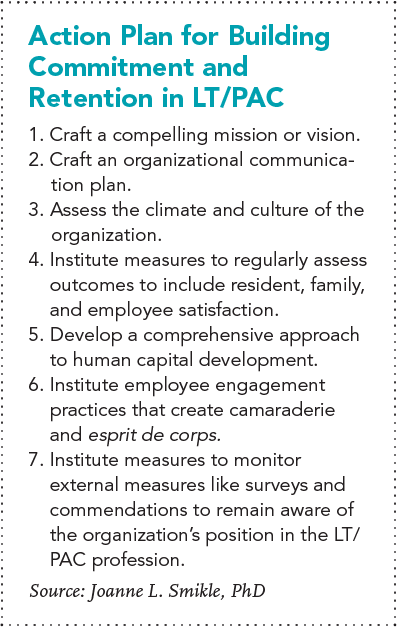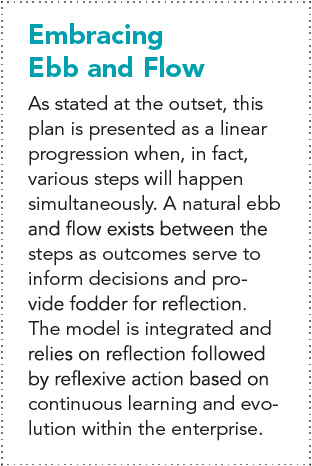Few health care providers have enviable retention, especially of direct care staff. Turnover statistics are startling throughout the care continuum, particularly in long term/post-acute care (LT/PAC).

Research from a 2015 study of employees at Opis Management Resources, a LT/PAC operator, has shown that, among other reasons, staff choose to stay working at an organization because they feel valued. This research also led to the development of seven action steps that have the potential to reverse the tide on turnover.
A Plan with Purpose
It is clear that a comprehensive approach for effective human capital utilization is an important tool that would benefit the LT/PAC profession. This action plan provides a framework for developing human capital in a strategic manner that aligns the people who do the work with significant strategic imperatives like retention and commitment. Like all organizational change initiatives, this model requires an executive champion, adequate resources, and executive commitment.
While the action plan is presented as a seven-step linear progression, steps may occur concurrently. There is blending and overlap. It is neither voluminous nor overly complex. Following the advice of leadership experts in a 2002 article published in Human Resource Planning titled, “Why the Leadership Bench Never Gets Deeper: Ten Insights About Executive Talent Development,” the plan presents key practices likely to produce tangible results, geared to the needs of the company.
The hallmark of the model is that it has the potential to develop a cadre of employees appropriately skilled, committed, and competent, whether they are direct care providers, executives, or any other position in the company. Further, it has the potential to create organizational improvements that make collaboration and communication the modus operandi of the LT/PAC enterprise.
The Seven Steps
The first step of the process is to craft a meaningful mission. It is clear from the 2015 research that having a mission and using it as a strategic and operational guide has produced results for the organization studied, Opis Management Resources. This is an important lesson that can be applied throughout many health care organizations. The mission should be more than flowery prose; it needs to have significance and be compelling.

Once the mission is crafted, it will be necessary to take the second step, develop a communication plan to disseminate the mission and the behavioral imperatives throughout the company. This plan will guide the creation of dialog among stakeholders. The communication plan is an important tool that will be used throughout the organization as additional interventions are launched. It is a mechanism for systematically gathering the multiple intelligences that exist at all levels of the enterprise.
It is necessary to gather data to determine how employees perceive the culture and environment in which they work. This will be accomplished with a culture or climate audit, the third step. A mixed method combining focus groups, surveys, and interviews will yield the most data. This approach will provide a picture of the organization from multiple perspectives. Gathering this baseline data will enable the organization to determine which interventions may be required to help employees develop positive feelings toward their employer and toward the larger LT/PAC profession.
Keeping Data Current
Data gathering must be an on-going venture. Hence the reason that it is critical to do the fourth step, regularly assess outcomes to include resident, family, and employee satisfaction. In order to build organizational commitment and reverse the tide on turnover, it will be necessary to institute measures to assess stakeholder outcomes. These data will enable the organization to have current, useful information on stakeholder perceptions and experiences. The initial and ongoing assessments help to identify strengths, weaknesses, and developmental needs throughout the organization. The data also serve as the launch pad for strategic organizational improvement efforts.
The communication plan is an important vehicle for maintaining dialog throughout each stage of the process. An element of the plan should include methods to report findings of the ongoing measurements. The organization used for this research has a communication tool called The Pulse. It is a televised broadcast of the chief executive officer and other leaders that is used to keep employees abreast of a wide range of issues within the organization. It is also used to provide short training updates and inspirational messages. The Pulse is a component of monthly all-staff meetings.
Getting the Best from Employees
The fifth step of the action plan, development of a comprehensive approach to human capital development, addresses the developmental needs of all levels of employees. This includes leadership and management, frontline staff, and non-caregiver development. Focused learning experiences are essential. This learning should be directly connected to the organization’s mission, the required competencies for each position, and standards that the organization has set for performance.
This approach to human capital development addresses the needs of every employee in the center. Some providers make the mistake of only offering the minimum required hours of training to direct caregivers. This is a minimal investment that produces minimal results. Instead, it is better advised to follow the example of the company studied and offer a comprehensive suite of developmental opportunities appropriate for each category of employee, including the most senior management.
As reported in the article “360 Degree Feedback and Leadership Development,” published in the International Journal of Selection and Assessment, this is of particular importance because “managers appear to have little knowledge of their own strengths and development needs.”

Each organization will create the appropriate developmental opportunities for its unique population of employees. There are important lessons learned from this research about the power of transformational leadership, which occurs when leaders broaden the interests of employees to appreciate the company’s mission and accept it as their own.
Transformational leadership has the power to create lasting, positive change in LT/PAC and throughout the care continuum. It has had an impact on the employees of Opis Management Resources, and it is reasonable to assume that it could have a positive influence in other health care settings.
An article published in Leadership & Organization Development Journal titled, “An Integrated Model and Approach for the Design of Effective Leadership Development Programs,” provides information on beginning the process of planning to use transformational leadership as a component of leadership development by “defining the key strategic objectives that are vital to the survival, success, and growth of the organization.”
All developmental interventions should be designed with care, especially those focused on leadership. These interventions can be pivotal, because “executive staffing and development [are] essential for organizational success” (Kessler, 2002, p.32).
Further Education
The comprehensive approach to human capital development goes beyond the learning experiences mentioned above. It also includes career paths, mentoring programs, and other interventions that create prospects for employees to reach their highest potential.
The framework for development should be structured and intentional, with monitoring mechanisms built in. Each of these structured interventions should consider a number of factors, including the function, education level, experience level, native language, and current assignments of the employee.
Moving to the sixth step in this action plan, instituting employee engagement practices that create camaraderie and esprit de corps, requires an assessment of the data gathered at the beginning of the process. It is important to have a clear understanding of the culture and climate—sentiments of employees and other stakeholders—before planning any engagement interventions.
The employee engagement strategies should directly reflect the interests, abilities, and aspirations of the employee population. They need not always be formal. They can include creating cross-functional, cross-level task forces to accomplish specific goals. They can include job-sharing or cross-training that allows employees to move outside of their normal sphere.
The final step of the action plan is to institute measures to monitor external measures like surveyors’ inspections, with their deficiencies and commendations, to remain aware of the organization’s position in the larger industry. It is important that the organization stay attuned to its industry position. It is equally important that it use the communication plan to keep employees abreast of issues and trends in the larger industry, as well as how the organization is faring at reaching its objectives and fulfilling its mission.
Joanne L. Smikle, PhD, partners with leaders to create organizations where retention, commitment, and engagement are the norm. She was recently appointed faculty in the Department of Leadership & Management at Saybrook University. She can be reached at (410) 730-4867 or info@smiklespeaks.com.